Functional Threshold Power

Now we're in to the big scary world of smoke and mirrors! Whether you know it or not, Functional Threshold Power (FTP) is one of the key factors of your cycling armoury.
But don't worry if you don't know what it is or why it should be important to you, you're not alone. Functional Threshold Power is a phrase that has as many perceived meanings as there are gears on a bike.
In this article we'll try to explain, what it is, why you should be interested in it and how you can go about understanding, measuring and improving it, to enable you to be a fitter, faster, stronger cyclist.
Before we start, a reality check. Whole books have been written on this subject, so we're not going to cover every nuance, or better still overcomplicate things, in a simple, one page article. I'll try to make this factsheet deep enough to portray a meaningful representation of the subject but not that deep as we end up drowning in science and psycho-babble. So here goes...
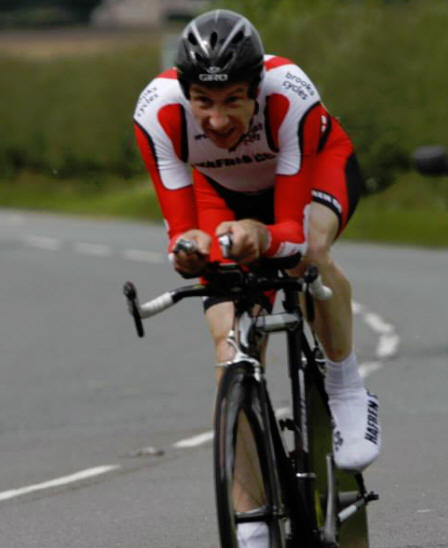
Medwyn Jones ~ FTP'ing to a Championship win
The General
Consensus
Functional Threshold Power is your maximal sustainable
aerobic power output you can hold for an extended period.
It's NOT your "average" power. As average has a different meaning in
a power context to "sustained". And for accuracy, it should be a steady state power
derived from a "flat" course.
Figures derived from a full on interval session, or climbing Alpe D'Huez, are a good indicator of your potential, but would skew any training zones related to these figures. So steady-state, iso-power it is.
There are many ways to compute, extrapolate or test for Functional Threshold Power and Dr Andrew Coggan seems to be the man with a plan when it comes to this area of cycling science. So who am I to contradict. Most of this article will be a reflection of the work of himself and others, with punditry and anecdotal insight from myself!
Your Starter for Ten...
Calculating your FTP is quite straightforward. If
you've got power meter analysis software (WKO+ see panel at the foot of
the page) you can use your race and
training data to accurately estimate your FTP through the Normalised
Power function at the 40-60 minutes axis point. If you're unsure
just email me and I'll send you a link.

Chris Stephens ~ warming up for a Ramp Test
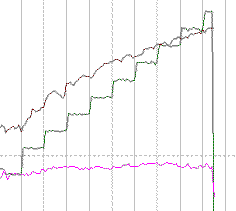
You could do a Ramp Test, a profile of which is seen here, and extrapolate the figures you need from its results. The final 60 seconds of sustained power are computed and approximately 75% of that gives you your approximate FTP.
An alternative is to carry out a six minute wVO2max Test and extrapolate your figures, from that. There is also a 20 minute test for slightly more accurate results or you could go the whole hog and do a one hour test (a 25 mile/40k TT) and get pretty much 100% accurate results from that.
You can also compute your FTP from your lactate threshold as the two are very closely related. They're not the same but they are near neighbours in the world of FTP figures.
Loads of ways to calculate it so there's no excuses for not having a ball park figure! You can even do it with heart rate alone, you don't need a power meter, although strictly speaking you obviously won't actually have your functional threshold power figures!

If you're anything like me (an accomplished slacker) you'll find it very difficult to concentrate for a full 60 minutes, especially when it starts hurting and there's no one to talk to. So a 20 minute test (shown above) is a good a way as any of getting some scores on the doors.
Crack out a full on 20 minute ride (a 10 mile TT), grab your normalised power figure, and you've got 105% of your approximate functional threshold. It's not as accurate as a full test, but it's less stressful, easier to fit in to a busy schedule, and as close as we need to be for the level of racing and training we undertake. Remember, this site is written for people who live in the real world!
Realising
your potential
Okay, now we've got a figure for our functional threshold what do
we do with it? Functional threshold development is all about
making our athletic engine more efficient.
As a competitive cyclist, raising FTP should be your primary objective. We need to become more efficient at making use of our overall effectiveness. Here I'll explain why.
Two riders can have exactly the same relative VO2max, but it will be the one with a higher Functional Threshold Power that prevails come judgement day; or the Island Championships as they're known in Jersey.
Even though two club riders may turn out exactly the same power over the course of an hour. Their physical attributes, heart volume, cardiac output, lung capacity, weight etc, would differ so their heart rates could be miles apart. The power outputs and the lines on the wattage graph may be the same but their physiological response, sensations and emotions most definitely won't!
There's more to this game than just high power figures.
Not
big and not clever
Power meter users often try to hit
the big maximal power numbers to reflect the measure of their prowess on the bike.
Mines bigger than yours type of thing.
I'm sorry to have to disappoint our macho men, but it's the biggest FTP that's going to do the damage when it matters not maximal power output. You may have a 1000 watt sprint but if you've only got a 200 watt FTP then you ain't going to be around at the end of the race to show everyone what a sprint god you are.
I've tested some phenomenally strong riders in the lab that would be dropped before they got to the first hill in the 25 mph "race to the base". As with all things at our level, moderation in everything is the key to success.
It's lactate tolerance, aerobic/anaerobic boundary that determines who'll be around for the sprint. It isn't necessarily the strongest sprinter in the race that takes home the medals.
You're more likely to be "in for a win" with a 900 watt sprint and a 300 watt FTP. Just redirect your focus to the less glamorous side of the training spectrum and reap the rewards.
Functional threshold power gives you a baseline from which which you can design your future training levels. Once you have enough power data to draw a conclusion, changing your FTP is pretty straightforward, it's hardly easy to do but is easy to target; if you get my meaning.
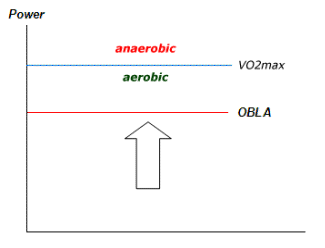
Sciency Stuff
We've described before that cardiovascular fitness (VO2max) sets the
ceiling for aerobic energy production. The higher your VO2max the
more power you can generate "with oxygen". The blue line limit is,
to a certain extent, genetically defined by our heart and lung capacity
gifted to us from the genes of our parents.
Your metabolic fitness (functional threshold) determines how close you can get to that ceiling without generating gallons of debilitating lactate and running out of puff. That's the diagram above. This is the bit we can influence through hard work, endeavour and restrained, controlled aggression.
Obviously our intention as a competitive cyclist is to move the red line as close as we can to the blue.
This is how we do it!
First you need to establish your FTP baseline. Re-read the
General Consensus
text above and decide how you are going to evaluate your current fitness
level and determine your functional threshold power.
Once you have
an accurate baseline figure we can now go to town on improving it and
transforming your season, your results and quite possibly your sexual
prowess. The final conclusion is from highly anecdotal evidence that
has little chance of being peer reviewed; but at least I've now got your
interest!
| Coggan's Power Training Levels | ||||
| Purpose | % of FTP |
Watts |
FTP = 300 watts | |
| 1 | Active Recovery | <55 | 165 | Smelling the Flowers! |
| 2 | Endurance | >75 | 225 | All day pace. |
| 3 | Tempo | >90 | 270 | Chain Gang pace. |
| 4 | Lactate Zone | >105 | 315 | 25m TT pace |
| 5 | VO2max | >120 | 360 | 3-8 min intervals |
| 6 | Anaerobic | 121+ | 360+ | Flamme Rouge SHITS |
| 7 | Neuromuscular | >1000 | Jump Intervals | |
In the table above we've taken
a rider with a a Functional Threshold Power of 300 watts. If you can
knock out a 25 mile TT in or around an hour you're in this region.
The table describes Coggan's Power Levels that have become the benchmark for many power meter users over recent years. Don't be misled in to thinking the levels are compartmentalised in to "black and white" discrete bins of power and physiological response.
There is a sliding line continuum that blends from one level to the next. It just fits our mindset better if we put it in to pretty coloured boxes. For instance you don't go from below 74% of FTP being wholly Endurance pace and 76% of FTP being wholly Tempo pace.
There is no physiological switch from one level to the next, just a sliding scale of effort that eases across the identified training responses. However the levels do give us a framework for understanding, developing and structuring, sustained improvement.
Obviously you don't need me to tell you that you can ride for longer at Level 1 than you can at Level 5. So I'll let Dr Coggan explain through the medium of graphs...
The Physiological Continuum
The Exercise Intensity graphic below is a companion to the
Coggan Training Levels in the table above.
You can see the gently decreasing volume duration (orange) line starts in the top left corner, and degrades to finish just after the start of level 7 at the bottom right. It drops through the coloured levels as it moves across the chart, visually indicating a hypothetical duration of effort for each physiologically identified power level.
What the above sentence effectively means is; "The harder you go, the less time you can go for".
The (yellow) line gently rising from the lower left to the upper right, reflects the physiological strain your training places on you. Again, it's fairly obvious that you can undertake many, many days of repeated Level 1 and Level 2 work but less so when you get to Level 5 and 6. "The harder you go, the more damage it does, the more recovery you need before doing it again".
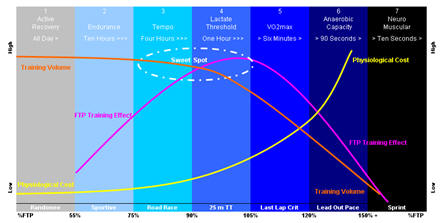
The (pink) "camel's hump," reflects the potential each Training Level has for increasing your Functional Threshold Power. Obviously it peaks out in the middle of Level 4.
At this point, physiological strain is increasing and sustainable volume is decreasing. So mid-level four appears to give us the maximum performance return. However, the physical cost is much too high a price to pay for most of us to be able to do this too often. Recovery from a mid-level four session is going to be longer than that of an upper level 3 session.
Unsurprisingly, muscle trauma is also greater. Which means you won't be able to undertake another quality workout as quickly as you might like. If you chase level four sessions, there is a possibility that, over the course of a medium term training period, you may, to a very small extent, detrain in comparison to someone who undertook the level 3 sessions.
Harder isn't necessarily always better. So, why not drop back to just under Level 4 and train for a longer duration. Less physical session advancement but much less physical stress giving you the ability to do another session in a quicker time frame.
Two 60 minute sessions at upper level three will give a better training return than one 90 minute session at mid-level four. Train smarter not harder!
Theory
into Practice
So what does all this mean in the real world? You can see
that the lines above begin to converge at around 85% of FTP. So that's where we
train. Take a test, get a figure, multiply it by 0.85 and go ride at
that figure for 2 x 20 minute intervals, twice a week. It really is that
simple!
Below are power charts from my turbo sessions specifically designed to increase FTP. In the winter preparation phase of my training my FTP is 240w. As we get to the pre-competition period it's 265w and I'll concentrate on getting it to 300w to 320w for the height of the sportive season.
The graphics below are all taken from the same one hour turbo session. A thorough progressive warm up, 2 x 20 minutes at threshold, with a four minute recovery between each, and a high-rev cool-down. Threshold power on the day was 265 watts and the session was undertaken in a nice, warm 16 degrees centigrade watching, Paris Roubaix for added motivation.
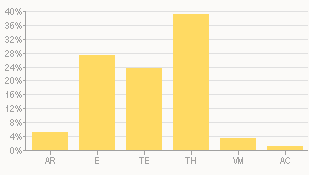
Here we see the ride broken down in to the specific power training levels described in the charts above.
AR ~ Active Recovery;
E~ Endurance
TE ~ Tempo
TH ~ Threshold
VM ~ VO2max
AC ~ Anaerobic Capacity
Just under 40% at Threshold.
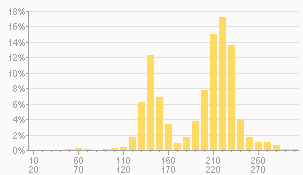
This graphic portrays the same information as that above.
But now we can see
the specific power ranges with each bar representing a 10 watt
spread of power.
The ranges to the left are the warm up & cool
down.
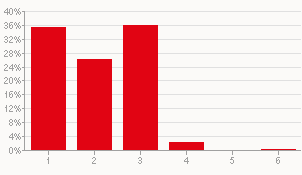
If you haven't got a power meter you can still get half-decent results with a heart monitor.
Again the same ride by heart rate. 36% in Zone 3 with a little cardiac drift sniff in to Zone 4.
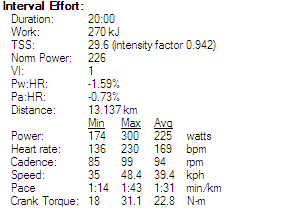 And
finally the breakdown of a single interval by numbers.
And
finally the breakdown of a single interval by numbers.
85% of 265 watts is 225.25 watts. You can see for yourself it's bang on the money.
In other factsheets I'll explain what all the numbers in the top half mean.
It's the bottom half figures that interest us for now.
Hour of Gain
Most of my turbo sessions are an hour of pain
but to be honest, this ones not that painful. This is a session that
really is more gain than pain. It's not easy by any means, it
requires concentration, control, a determination to hold back and a big
fan to keep you cool!
The FTP development Session consist of;
▼ 10 minute controlled warm up with bursts up to FTP
▼ 20 minutes @ 85% FTP
▼ 4 minutes recovery @ 150 watts maximum
▼ 20 minutes @ 85% FTP
▼ 6 minutes cool down spinning at 100 rpm
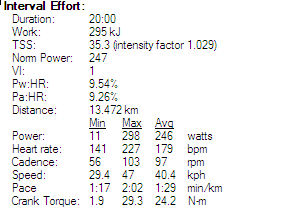
Six weeks on from my sessions above, I knocked out the following interval. With results you can all see and achieve yourselves.
A refreshing 21 watt increase, or 10% if you wish!
Heart rate up 10 beats which for me isn't a lot, you can see my max of 230 ish!
Speed up 1 kph , revs up 3 rpm and an
increased distance of 335 meters. Job done.
To Summarise
So there it is. Get tested, by doing it yourself or in a lab; get
your approximate Functional Power Threshold numbers, do some really easy maths, train
at the right level twice a week for three weeks. Take a recovery
week, measure yourself
again and recalculate the figures for your next batch of three weeks'
sessions.
It really is that simple and that quick. And it's a 100% sure fire hit of increasing your threshold, your performance and your enjoyment on the bike.
Other than a race win, there is little more satisfying experience on a bike than knowing the training your doing is bringing results. It's such a gratifying feeling, as an athlete and a coach, to see immediate, sustained, measurable progression.
If the rewards aren't enough to accept the lack of variety, then don't feel there isn't an alternative. These intervals don't have to be carried out as an exclusive session.
Why not do a one hour turbo session in the week based on this work out. Then include the other 20 minute sessions as part of a road ride. I try to get my big distance sportive riders and Iron Man athletes to include a 20 minute controlled burn up in every hour of their long weekend rides as part of their Pre-Competition build up. The results they bring, as you can see, are spectacular.
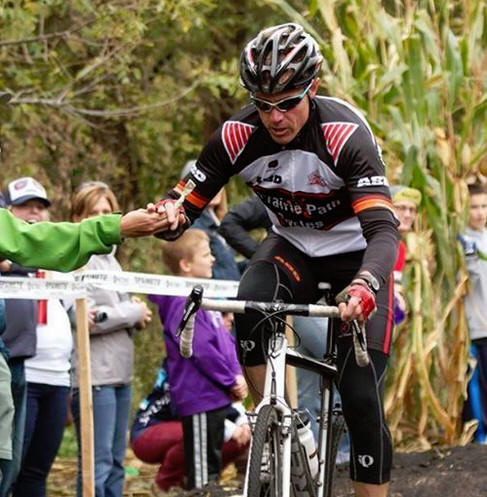
Jerry Meister ~ The ultimate FTP Test Cross Racing!
The
Message
Hopefully this factsheet has provided the
information to help you take your threshold power to the next level.
You don't advance your power output by riding around for three hours on a club run at whatever speed the leaders choose; or knocking out 1000 watt intervals for 5 seconds at a time. There is a sweet spot or, as you'll find when banging it out on the turbo, a sweat spot, that brings returns that far exceed the perceived effort. And I'll vote for that any day.
These intervals should not be a bare all, gritted teeth, hang on for grim death, type effort. They should be a controlled effort on the edge of aerobicity (my new word from last month!). You are not Einstein, you can't redefine the laws of physics. The maths, the workout and the results are simple;
▼ 85% of FTP for 20 mins = continuous improvement
So stay at that intensity and reap the rewards. If you want to make the interval harder, cut the rest interval by one minute per week. Then after your recovery week, increase the effort and reinstate the 4 minute recovery period.
DO NO'T increase the wattage because you think you can. Of course you can pedal as hard as you want you just won't get the results you were expecting. Rein it in and wait for the gains to arrive; show restraint and save your pent up energy for the races.
Functional Threshold Power can be described to a layman as "how fast you can cruise." Cruising plays a major part in endurance sports such as cycling and being efficient at high cruising speeds is our ultimate aim.
The fresher you are when you get to the finish the better position you'll be in physically and mentally for the finale of the end game and the race winning sprint. Enjoy the rewards of your 85% efforts because they bring 100% results.
And if anyone has any information to backup the sexual prowess claim, feel free to email me and I'll share it with our ever increasing world-wide readership!
If you would like an "enhanced" FTP Development Programme, why not take a look at this link, and purchase one of our infamous, "reusable", bargain of the cycling word, £15 ($25), 8 week FTP Development Programmes
Until next time...
Thank you for reading this far; there have been recent developments in FTP
"understandinig" that have needed "clarification".
Here's a bit more on what's stayed the same (FTP) and
what's changed in how it's described, understood, deployed...








